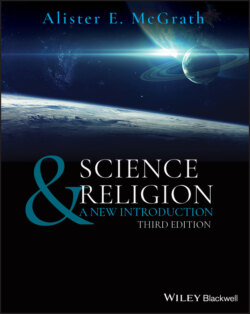Читать книгу Science & Religion - Alister E. McGrath - Страница 10
Conflict
ОглавлениеHistorically, the most significant understanding of the relation between science and religion is that of ‘conflict’, or perhaps even ‘warfare’. This strongly confrontational model continues to be deeply influential at the popular level, even if its appeal has diminished considerably at a more scholarly level. ‘The war between science and theology in colonial America has existed primarily in the cliché‐bound minds of historians’ (Ron Numbers). This influential model was expounded in two influential works published in the later part of the nineteenth century – John William Draper's History of the Conflict between Religion and Science (1874) and Andrew Dickson White's History of the Warfare of Science with Theology in Christendom (1896). The best‐known late twentieth century representative of this approach is Richard Dawkins, who argues that: ‘Faith is one of the world's great evils, comparable to the smallpox virus but harder to eradicate.’ For Dawkins, science and religion are implacably opposed.
Yet this model is not restricted to anti‐religious scientists. It is widespread within conservative religious groups within Christianity and Islam, who are often virulently hostile to the idea of biological evolution. The creationist Henry M. Morris (1918–2006) published a sustained critique of modern evolutionary theory with the title The Long War against God (1989). In an appreciative foreword to the book, a conservative Baptist pastor declares that: ‘Modern evolutionism is simply the continuation of Satan's long war against God.’ Morris even invites us to imagine Satan imagining the idea of evolution as a means of dethroning God.
Yet many of the historical episodes that are traditionally placed in this category, or held to represent its manifestation, can be interpreted in other ways. The Galileo controversy of the seventeenth century, for example, is still presented as a classic example of ‘science against religion’, even though it is now recognized to be a much more complex and nuanced matter. Similarly, Darwin's theory of evolution is often presented in the popular media as anti‐religious in nature and intention, even though Darwin himself was adamant that it was not. Indeed, in 1889 the Anglican theologian Aubrey Moore remarked that: ‘Darwinism appeared, and, under the disguise of a foe, did the work of a friend.’ The issue of whether science and religion are in conflict all too often seems to rest on complex issues of interpretation, which are often sidelined by those looking for simple answers and slick slogans.
More importantly, the conflict model is increasingly being seen as a distinctively Western way of thinking, which is grounded in the specific histories and the implicit cultural norms of Western nations, particularly the United States of America. Researchers have noted that the relation of science and religion in non‐Western cultures – such as India – is understood in a very different (and much more positive) way. Recent surveys indicate that the general approach which Barbour designates ‘independence’ (see below) is dominant amongst scientists in North America and Western Europe, whereas a more collaborative or dialogical approach is dominant within scientific communities in Asia.
Although some Western cultural commentators regard the ‘warfare’ model as normative, it is nothing of the sort. It is simply one option within a spectrum of possibilities, which became influential as a result of a set of historical circumstances, rather than having anything to do with the essential nature of either science or religion. Furthermore, the ‘conflict’ model retains its credulity largely on account of conflicts arising from very specific issues – chiefly the teaching of evolution in schools and issues of therapeutic gene modification.
